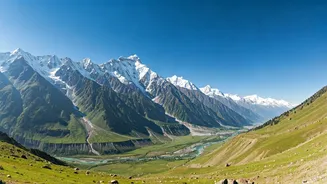Climate Talks: A History
India's involvement in international climate discussions has a rich history, reflecting its evolving stance on environmental issues. Over time, India has engaged
in critical dialogues and negotiations, contributing to the global effort to address climate change. This has involved participating in significant conferences and contributing to climate change funds. This engagement is a reflection of its commitment to environmental protection and sustainable development, even as the nation balances its economic development aspirations with climate goals. Its position has shifted, adapting to global environmental trends and growing scientific evidence of climate change.
Impact on the Land
The integrity of India's land is facing considerable challenges due to climate change. Rising temperatures and erratic weather patterns are causing significant damage to natural resources and ecosystems. These changes have an effect on agriculture, water resources, and overall biodiversity. Rising sea levels and coastal erosion are also serious concerns, threatening populated areas and key infrastructure. Addressing land degradation and implementing sustainable land management practices are crucial for enhancing resilience and safeguarding the country's ecological and economic assets. Mitigation strategies are vital to protect India's land and ensure the well-being of its citizens.
Early Warning Systems
India has been developing early climate warning systems to prepare for and minimize the impact of extreme weather events. While there have been advancements, complete readiness has not yet been achieved. These systems are designed to provide timely information about impending disasters like cyclones, floods, and heat waves, thereby enabling preemptive measures and minimizing losses. Despite progress in weather forecasting and monitoring, the country still struggles to predict and respond to extreme events. Efforts are underway to strengthen these systems through technological upgrades and wider community involvement, aiming for increased efficiency and reliability.
Heat Waves' Impact
India's efforts to protect its population from the effects of heat waves are challenged by the rising frequency and intensity of these events. The increase in heat waves poses significant dangers to public health, especially for the vulnerable, including the elderly, children, and those with pre-existing conditions. Effective adaptation strategies require a multi-faceted approach, incorporating measures like improved urban planning, public awareness campaigns, and providing accessible healthcare during heat wave events. The implementation of early warning systems and efficient emergency response plans is essential to reduce the fatality rates. Further investment in infrastructure is vital to protect lives and manage the increasing challenges posed by extreme heat.
Energy Demand and Climate
Meeting India's rising energy demand while maintaining its climate goals poses a considerable challenge. The country's economic growth and growing population have fueled a surge in energy needs. Balancing these demands with the need to decrease carbon emissions requires strategic investments in renewable energy sources, energy efficiency initiatives, and improved grid infrastructure. India is actively pursuing its commitments to increase its renewable energy capacity, which includes solar, wind, and hydropower. Developing and adopting clean energy technologies are crucial for sustainable development while also assisting in the battle against climate change.
The 'Loss and Damage' Fund
India's involvement in the 'Loss and Damage' fund is crucial as the country advocates for financial assistance to handle climate-related impacts. This fund helps countries cope with extreme weather events and long-term climate changes that result in irreversible harm. India is working to promote this concept within international climate negotiations to ensure it meets the needs of developing nations. This involves creating funding mechanisms, and establishing clear guidelines for the use and distribution of resources. India's active participation in this fund illustrates its commitment to climate justice and supports the concept that wealthier nations have a responsibility to assist countries in coping with the effects of climate change.
Water Resources: Complexity
The management of India's surface water resources is highly complex, intensified by climate change. Climate change affects the availability and distribution of water resources, leading to water shortages and stress on agriculture and ecosystems. Addressing these challenges requires integrated water resource management, the promotion of water conservation, and improved water efficiency practices. Adapting to the effects of climate change includes investing in infrastructure projects, improving irrigation systems, and encouraging the adoption of efficient water technologies. The careful management of water resources is critical for sustaining India's population and safeguarding its future from the effects of climate change.
Cryosphere Crisis: Himalayas
The Himalayas face a critical cryosphere crisis due to climate change, including rapidly melting glaciers and increasing water scarcity. Melting glaciers impact water supplies and threaten communities. This issue calls for rapid adaptation strategies to address water shortages and mitigate the effects of environmental changes. Promoting innovative water management practices, constructing water storage facilities, and using sustainable agricultural methods are essential. In addition, the long-term protection of the Himalayas demands global efforts to limit greenhouse gas emissions, preserve biodiversity, and assist those affected by climate change. Addressing this cryosphere crisis is critical for the stability of the Himalayan region and its contribution to the global environment.
Trees and Climate Change
Trees provide a valuable tool in the fight against climate change, but they also have certain problems associated with their use. Trees absorb carbon dioxide, which reduces greenhouse gas emissions. However, the benefits of using trees are affected by issues such as deforestation, poor planning, and the vulnerability of forests to pests and wildfires. Implementing sustainable forestry practices, promoting reforestation, and protecting existing forests are critical to maximizing the benefits of trees in mitigating climate change. Addressing the environmental concerns associated with planting trees, such as the use of monoculture plantations, is necessary to make tree planting programs sustainable.














